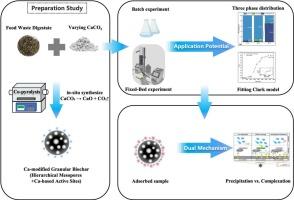Calcium modification in food waste digestate derived granular biochar: unveiling synergistic mechanisms for phosphorus recovery
IF 9
1区 工程技术
Q1 ENGINEERING, CHEMICAL
引用次数: 0
Abstract
Phosphorus (P) is a primary concern in wastewater. It is crucial to develop efficient adsorbents for long-term P removal from wastewater. In this study, we proposed a calcium carbonate (CaCO3) enhanced granular biochar (BC) adsorbent by co-pyrolysis of food waste digestate, and systematically evaluated the adsorbent properties and adsorption mechanism. Material characterization has verified that in-situ Ca loading via 4–10 nm pore filling improves surface functional groups and enhances biochar yield. The adsorbent prepared with 10 % CaCO3 achieved the best phosphorus removal capacity (18–20 mg-P/g-BC) versus unmodified counterparts (8–10 mg-P/g-BC). The adsorption followed Langmiur isotherm model and Pseudo-second-order kinetics. Calcium induced active sites enhanced the phosphate trapping with optimal phosphate removal occurring at pH 6–9. Modification with excessive CaCO3 (20 %) induced structural fragility, and the Ca P precipitate overformation hindered the further phosphate adsorption. Fixed-bed column adsorption revealed prolonged saturation thresholds (>125 h), and the adsorption fitted well with the Clark mass-transfer model (R2 = 0.992). Notably, equilibrium between complexation and precipitation mechanisms was achieved at the 10 % CaCO3 modification. This study establishes a strategy for optimizing granular P adsorbent systems through controlled mineral modification, thereby providing theoretical and practical foundations for full-scale phosphorus recovery deployment.
P precipitate overformation hindered the further phosphate adsorption. Fixed-bed column adsorption revealed prolonged saturation thresholds (>125 h), and the adsorption fitted well with the Clark mass-transfer model (R2 = 0.992). Notably, equilibrium between complexation and precipitation mechanisms was achieved at the 10 % CaCO3 modification. This study establishes a strategy for optimizing granular P adsorbent systems through controlled mineral modification, thereby providing theoretical and practical foundations for full-scale phosphorus recovery deployment.

食物垃圾消化衍生颗粒生物炭中的钙改性:揭示磷回收的协同机制
磷(P)是废水中的主要问题。开发高效的吸附剂来长期去除废水中的磷是至关重要的。在本研究中,我们提出了一种碳酸钙(CaCO3)增强颗粒生物炭(BC)吸附剂的共热解食物垃圾消化,并系统地评估了吸附剂的性能和吸附机理。材料表征证实,通过4-10 nm孔隙填充原位加载Ca可以改善表面官能团,提高生物炭产量。与未改性的吸附剂(8-10 mg-P/g-BC)相比,10 % CaCO3制备的吸附剂具有最佳的除磷能力(18-20 mg-P/g-BC)。吸附过程符合Langmiur等温模型和拟二级动力学。钙诱导的活性位点增强了磷酸盐捕获,pH为 6-9时磷酸盐去除效果最佳。过量的CaCO3(20 %)改性导致结构脆性,CaP沉淀过度形成阻碍了进一步的磷酸盐吸附。固定床柱吸附显示出较长的饱和阈值(>125 h),吸附符合Clark传质模型(R2 = 0.992)。值得注意的是,在10 % CaCO3改性下,络合和沉淀机制达到了平衡。本研究建立了通过可控矿物改性优化颗粒磷吸附剂体系的策略,为磷的全面回收部署提供了理论和实践基础。
本文章由计算机程序翻译,如有差异,请以英文原文为准。
求助全文
约1分钟内获得全文
求助全文
来源期刊

Separation and Purification Technology
工程技术-工程:化工
CiteScore
14.00
自引率
12.80%
发文量
2347
审稿时长
43 days
期刊介绍:
Separation and Purification Technology is a premier journal committed to sharing innovative methods for separation and purification in chemical and environmental engineering, encompassing both homogeneous solutions and heterogeneous mixtures. Our scope includes the separation and/or purification of liquids, vapors, and gases, as well as carbon capture and separation techniques. However, it's important to note that methods solely intended for analytical purposes are not within the scope of the journal. Additionally, disciplines such as soil science, polymer science, and metallurgy fall outside the purview of Separation and Purification Technology. Join us in advancing the field of separation and purification methods for sustainable solutions in chemical and environmental engineering.
 求助内容:
求助内容: 应助结果提醒方式:
应助结果提醒方式:


